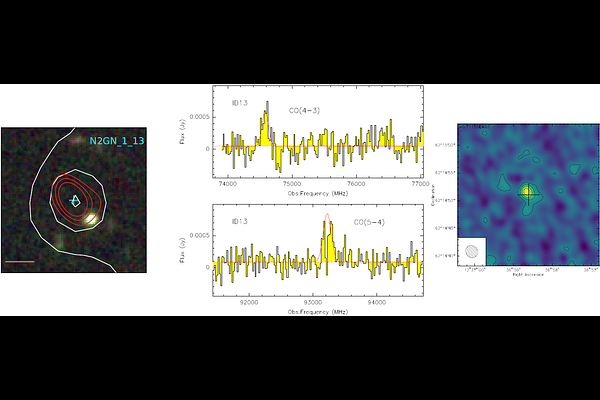Overdense fireworks in GOODS-N: Unveiling a record number of massive dusty star forming galaxies at z$\sim$5.2 with the N2CLS

Overdense fireworks in GOODS-N: Unveiling a record number of massive dusty star forming galaxies at z$\sim$5.2 with the N2CLS
G. Lagache, M. Xiao, A. Beelen, S. Berta, L. Ciesla, R. Neri, R. Pello, R. Adam, P. Ade, H. Ajeddig, S. Amarantidis, P. André, H. Aussel, A. Benoît, M. Béthermin, L. -J. Bing, A. Bongiovanni, J. Bounmy, O. Bourrion, M. Calvo, A. Catalano, D. Chérouvrier, U. Chowdhury, M. De Petris, F. -X. Désert, S. Doyle, E. F. C. Driessen, G. Ejlali, A. Ferragamo, A. Gomez, J. Goupy, C. Hanser, S. Katsioli, F. Kéruzoré, C. Kramer, B. Ladjelate, S. Leclercq, J. -F. Lestrade, J. F. Macías-Pérez, S. C. Madden, A. Maury, F. Mayet, A. Monfardini, A. Moyer-Anin, M. Muñoz-Echeverría, I. Myserlis, P. Oesch, A. Paliwal, L. Perotto, G. Pisano, N. Ponthieu, V. Revéret, A. J. Rigby, A. Ritacco, H. Roussel, F. Ruppin, M. Sánchez-Portal, S. Savorgnano, K. Schuster, A. Sievers, C. Tucker, R. Zylka
AbstractAs part of the N2CLS Survey, we have identified a remarkable overdensity of ten bright dusty star-forming galaxies at z$\sim$5.2 in the GOODS-N field. Three of these galaxies, N2GN_1_01, 06, and 23 (known as GN10, HDF850.1, and S3, respectively), had previously been spectroscopically confirmed as members of the exceptional large-scale structure at z$\sim$5.1-5.3, which is notably elongated along the line of sight, spanning 30 cMpc. We present the spectroscopic confirmation of N2GN_1_13 at z$_{\rm spec}$=5.182, a massive dusty star-forming galaxy identified through targeted NOEMA observations, and N2GN_1_61 at z$_{\rm spec}$=5.201, revealed using JWST/FRESCO data. In addition to these five spectroscopically confirmed members, we identify five further candidates with photometric redshifts consistent with the overdense structure. These galaxies are massive (with a median stellar mass of 10$^{11}$ M$_{\odot}$) and highly obscured (with a median A$_V$ of 2.9), caught in a short-lived yet extreme starburst phase at z$\sim$5.2. Their high SFRs (with a median of 680 M$_{\odot}$ yr$^{-1}$), efficient baryon to stellar mass conversion ($\epsilon_{\star}>$20%), substantial gas reservoir and dust content, suggest rapid evolution and imminent quenching. Six of these galaxies reside in overdense filaments, while the remaining four may trace new distinct structures which will have to be spectroscopically confirmed. These few dusty galaxies dominate the star formation within the overdensity, contributing more than the numerous H$_{\alpha}$ emitters, and surpassing the cosmic average star formation rate density for this epoch. Their properties suggest an accelerated evolution that current models and simulations have difficulty reproducing.